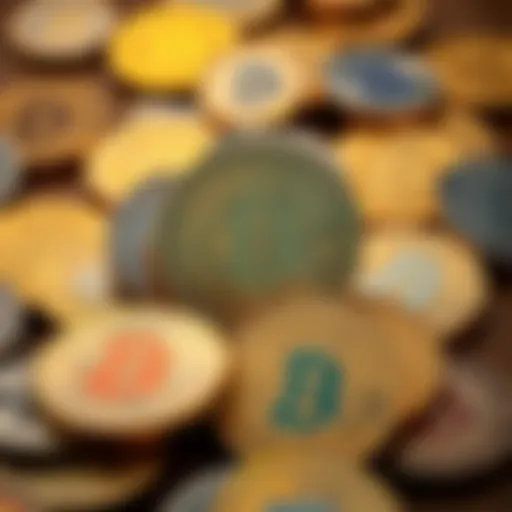Crafting Your Art NFT: A Comprehensive Guide
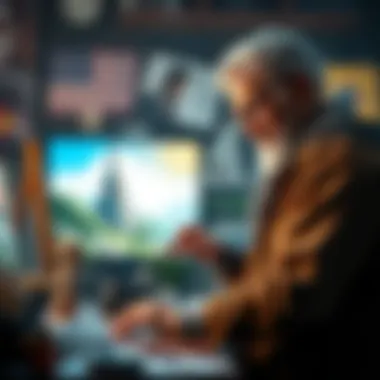

Intro
In recent years, the world of digital art has undergone a transformation, thanks to Non-Fungible Tokens (NFTs). The term has become increasingly popular, yet many artists and creators still find themselves navigating uncharted waters. The very idea of minting, buying, or selling art as an NFT can be daunting. However, with a bit of clarity and guidance, it can become a rewarding venture.
This comprehensive guide caters to artists who are eager to explore this digital frontier. We’ll immerse ourselves into the nitty-gritty involved in creating and launching art NFTs. From delving into the foundational concepts of NFTs to the technical skills required and strategies for marketing, we aim to equip you with the essential know-how. Throughout this guide, not only will you learn about the platforms available for minting NFT art, but you'll also get insights into marketing strategies that resonate with audiences today. Moreover, it’s pivotal to recognize the impact of the evolving landscape of NFTs on the contemporary art world.
Now, let’s dive into the latest trends in cryptocurrency, as they lay a crucial backdrop for understanding NFTs and the broader art market.
Understanding NFTs and Their Impact
The realm of digital art is undergoing a transformation like no other, and at the heart of this evolution lies Non-Fungible Tokens (NFTs). This section unpacks their significance, providing artists and stakeholders the roadmap they need to navigate this exciting landscape.
Defining Non-Fungible Tokens
Non-Fungible Tokens, often shortened to NFTs, are a type of digital asset that represent ownership or proof of authenticity of a unique item on a blockchain. Unlike cryptocurrencies like Bitcoin or Ethereum, which are fungible—meaning one coin can be exchanged for another without losing value—NFTs are irreplaceable. Imagine having a one-of-a-kind baseball card; that’s an NFT in the digital world. Each token is verifiable and stands on its own, proving ownership through decentralized methods.
The technology behind NFTs employs blockchain—specifically, Ethereum—enabling transparency in ownership records. Each time an NFT changes hands, its transaction history becomes part of the blockchain ledger. In essence, it's like having a digital fingerprint that can’t be duplicated. This characteristic is crucial because it addresses the age-old challenge of how to prove ownership in the digital space.
The Evolution of Digital Art
The digital art scene has been around for a while now, but the rise of NFTs has sparked a renaissance in how we perceive and value art. Digital artists previously faced hurdles when trying to monetize their works, often giving away pieces for free or losing control over copyrights. However, as artists began to embrace NFTs, a new market emerged, one where they could not only sell their art but also retain certain rights and even earn royalties from future sales.
Artists such as Beeple have taken the art world by storm by selling their work for millions, transforming the perception that digital art is less valuable than traditional mediums like painting or sculpture. The evolution of digital art, therefore, is closely tied to the adoption of NFTs, which has introduced concepts of scarcity and uniqueness to digital works.
"The art world is no longer confined to canvases and galleries; it now spans the entire digital realm."
Why NFTs Matter for Artists
For artists, NFTs represent more than just a new platform to sell their art. They signify empowerment and an opportunity to engage with their audiences on their terms. The advantages of using NFTs include:
- Direct Revenue: Artists can monetize their digital creations directly without intermediaries like galleries or auction houses taking a hefty cut.
- Royalties on Resales: Many NFT platforms allow artists to earn a percentage every time their work is sold in the secondary market. This means more continuous income from their creations.
- Building a Digital Identity: NFTs help artists build a personal brand within the digital community, showcasing their work and establishing a reputation.
Furthermore, NFTs broaden the horizon for artists to collaborate across various sectors—merging visual art with music, fashion, and gaming, which can lead to creatively enriching and profitable endeavours.
Choosing the Right Platform for Minting
In the fast-paced world of digital art, choosing the right platform for minting your art NFTs becomes a pivotal step in your artistic journey. A platform is more than just a place to upload your work; it can shape the exposure and potential value of your creations. Selecting the right one is not merely a matter of convenience; it influences how your work is perceived and appreciated in the ever-evolving NFT landscape.
An Overview of Popular NFT Marketplaces
The NFT marketplace is teeming with options, each boasting distinct features tailored to various artist needs. Some popular platforms include:
- OpenSea: One of the largest NFT marketplaces, known for its vast selection and user-friendly interface.
- Rarible: This platform is community-driven, allowing creators to mint and sell their art while also earning governance tokens.
- Mintable: An easy-to-use platform that supports the minting process without requiring coding skills, offering both free and gas-fee options.
- Foundation: A more exclusive platform that curates artists, focusing on high-quality digital art.
- Zora: Renowned for enabling artists to control their pricing while offering a unique experience for collectors and creators alike.
Each platform has a unique character, appealing to different types of artists and collectors. Take your time to explore each option. Their strengths can vary significantly, from community engagement to ease of use.
Factors to Consider When Selecting a Platform
When picking a marketplace for minting your NFTs, it's essential to weigh several factors:
- Audience Reach: Larger platforms like OpenSea have many users, which might increase your chances of selling.
- Ease of Use: Some platforms offer simpler interfaces than others, which can be crucial for artists who are less tech-savvy.
- Minting Fees: Every marketplace has its own fee structure; some platforms charge gas fees, while others may take a commission on sales.
- Royalties: Check if the platform allows you to set up royalties for future sales. This could be a game-changer for your ongoing income.
- Support and Resources: Some platforms offer tutorials, community support, and resources that can help you navigate your NFT journey more smoothly.
Evaluating Fees and Commissions
Fees and commissions can eat into your profits, so it's essential to understand them thoroughly before you make a decision. Here’s what to look for:
- Gas Fees: Fees related to the transaction on the blockchain. These can fluctuate wildly, especially on networks like Ethereum.
- Listing Fees: Some platforms might charge for listing your NFTs, while others allow free listings. Understand these costs upfront.
- Commission Rates: Typically, platforms take a percentage of your sale. Most operate between 2.5% and 15%. Factor this into your pricing strategy.
To sum it up, careful consideration when choosing the right platform can determine the success of your minting experience. A thorough understanding of each marketplace's strengths and weaknesses will set you up for better visibility and potential sales in this competitive online gallery.
"Choosing the right platform is like picking the right stage for your art to shine; the stage can either elevate your performance or limit your audience."
For further insights into NFTs and marketplace comparisons, you can check resources like Wikipedia or forums on Reddit for community discussions and updates.
Creating Your Digital Art
In the realm of NFTs, the journey begins with creating captivating digital art. This part isn’t just about putting paint on a canvas or manipulating pixels on a screen; it's about capturing the essence of creativity in a form that resonates with today's digital audience. For artists, having the right tools and techniques at their disposal can make all the difference in how their work is perceived and sold. Digital art serves as the foundation upon which NFTs are built, making it vital to understand the elements that contribute to its creation.
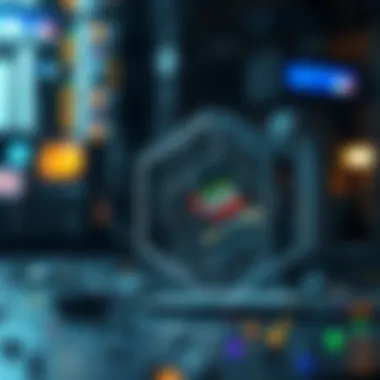
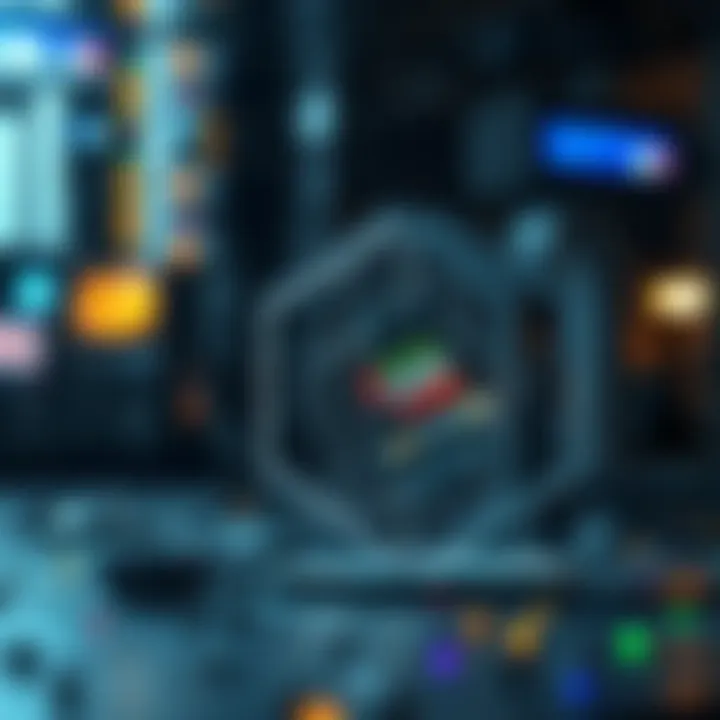
Essential Tools for Digital Art Creation
Creating digital art requires more than just imagination—it demands the right tools that cater to one's artistic style and workflow. Artists must navigate a variety of applications and hardware to find what suits them best. Some common tools include:
- Drawing Tablets: These devices like the Wacom Cintiq or Huion Kamvas allow artists to draw directly onto a screen, offering a natural feel akin to traditional drawing while providing the flexibility of digital editing.
- Software: Tools like Adobe Photoshop, Corel Painter, and Procreate empower artists with a multitude of brushes and effects, allowing for detailed and intricate designs. Each platform has its own unique capabilities, so selecting one that aligns with your style is crucial.
- Vector Graphic Editors: Programs like Adobe Illustrator or Affinity Designer are essential for artists who create scalable designs without loss of quality. Vectors are particularly important in creating logos and icons that may find their way into the NFT space.
Utilizing these tools effectively allows artists to express their individuality while catering to the preferences of collectors in the NFT market.
Exploring Artistic Styles for NFTs
The variety of artistic styles available for NFTs reflects the diverse tastes of collectors. As an artist, developing a distinctive style can set you apart in a crowded digital landscape. Understanding the nuances between different styles can help in crafting artwork that resonates with a specific audience. Popular styles include:
- Generative Art: Using algorithms to create unique, sometimes unpredictable, pieces. Artists like Tyler Hobbs work within this realm, creating complex visuals that intrigue tech-savvy collectors.
- 3D Art and Animation: As the NFT market evolves, 3D art continues to gain traction. Platforms like Blender offer artists the chance to create immersive experiences for their collectors, enhancing the value of their digital creations.
- Pixel Art: This retro style has grown in popularity, especially within gaming communities. Artists can create nostalgic, low-res artworks that evoke fond memories while appealing to a younger audience.
As you explore these styles, consider how they can blend with your personal artistic voice to create something fresh and exciting in the NFT marketplace.
Ensuring Quality and Resolution
Quality plays a pivotal role in how your artwork is received. High-resolution images not only enhance visual clarity but also elevate the perceived value of your artwork. Maintaining quality entails ensuring that your assets meet specific requirements:
- Resolution: Aim for a minimum of 300 DPI (dots per inch) for prints, while digital releases can vary based on platform recommendations. For NFTs, something around 2000 x 2000 pixels or higher helps guarantee sharp detail.
- File Formats: Understand the different formats such as JPEG, PNG, and GIF, each serving different purposes. PNGs support transparency and are ideal for images that might need layering, while GIFs are perfect for simple animations.
- Color Profiles: Using the correct color profile (such as sRGB for digital screens) ensures that your colors appear as intended across various devices.
Maintaining high quality not only shows professionalism but can also influence collectors’ perceptions, potentially leading to higher sale prices.
"The digital canvas is your playground. Quality investment in tools and skills can enhance not just your art but your reputation in the NFT space."
As you navigate through the creative process, consider these elements carefully. With the right foundation, your digital art can truly stand out in the burgeoning world of NFTs.
Minting Your Art NFT
The process of minting an art NFT is often considered the heart and soul of the NFT journey for artists. While creating your digital artwork is a crucial step, minting essentially transforms this creation into a tradeable asset on the blockchain. This transformation is where the magic happens, giving value to what you have designed and ensuring that your ownership is recognized securely.
Minting is the bridge between the digital world and the tangible economy, allowing artists to capitalize on their creativity in ways that were previously unimaginable. Moreover, it introduces the creator to a broader audience, enabling them to sell their work without traditional gatekeepers such as galleries and auction houses.
Understanding the Minting Process
Minting is straightforward when you break it down into its core components. At its essence, minting refers to the process of publishing your digital artwork on the blockchain network, specifically converting it into a non-fungible token. Each blockchain has its own mechanism for minting, and understanding these can give you a leg up.
Here's a quick overview of what happens during the minting process:
- Choosing the Blockchain: Different blockchains, like Ethereum, Tezos, or Binance Smart Chain, support NFTs but come with various transaction fees and environmental concerns.
- Creating a Wallet: A digital wallet is necessary for storing your NFTs and cryptocurrencies. This wallet will facilitate all transactions related to your NFTs.
- Using a Smart Contract: When you mint an NFT, a smart contract handles the flow of information regarding ownership. This contract can also embed royalties for future sales.
Each aspect of minting can vary, but the fundamentals remain relatively constant across platforms.
Step-by-Step Guide to Minting
Minting your art NFT can be gear shifting, and when you know the drill, you can speed through it. Here’s a streamlined step-by-step guide to make the process simpler:
- Select Your Art: Choose the digital piece you want to tokenize. Quality and uniqueness play key roles here.
- Pick an NFT Marketplace: As mentioned earlier, the marketplace you choose affects not just visibility but the fees involved. Make sure to pick one that aligns with your objectives.
- Upload Your Art: On the selected platform, you’ll need to upload your art. This often includes filling out details on title, description, and price.
- Mint the Token: Here’s where the real action happens. Follow the platform's specific instructions to complete the minting process. Confirm and sign any transaction prompts that pop up on your wallet.
- Set Royalties (if applicable): Most platforms allow you to set royalty percentages. This ensures you earn money on future sales of the NFT.
- Confirm Minting: Once you finalize everything, your NFT will be created and stored in your digital wallet, ready to be flaunted or sold!
Metadata and Its Significance
At first glance, metadata might seem like mumbo jumbo, but it’s one of those behind-the-scenes players that holds incredible significance in the world of NFTs. The metadata is the information stored within the token that describes your NFT.
Important components typically include:
- Title and Description: This helps potential buyers understand the essence of your work.
- Creator Information: Ensures proper attribution stays with the artist (you).
- Media Links: Points back to where your artwork is housed, which can be essential if you decide to change platforms later.
- Royalty Settings: Details how much of a cut you will take on secondary sales.
To put it bluntly, the metadata makes your NFT meaningful and facilitates certain features like resale royalties. Without it, your NFT is just an empty shell.
In essence, minting your art NFT is a blend of creative pursuit and technical savvy. It turns your passion into profit, allowing you to engage with a community that appreciates digital innovation. As you stand at the cusp of this thrilling digital frontier, remember that each step counts. Whether you are diving deep into understanding the nitty-gritty of blockchain or promoting your newly minted masterpiece, each moment brings its own learning experience, shaping your journey as a digital artist.
"The beauty of NFTs lies not only in the art but also in the stories behind them. Each minting process tells a part of that story."
With these tools and insights in your arsenal, you're well on your way to navigating the NFT landscape successfully.
Legal Considerations and Ownership Rights
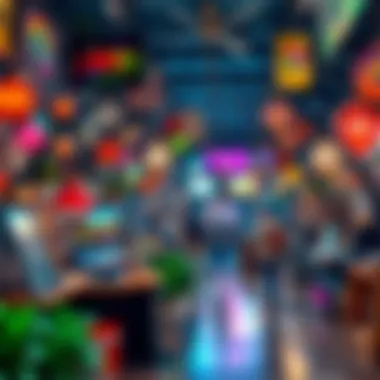
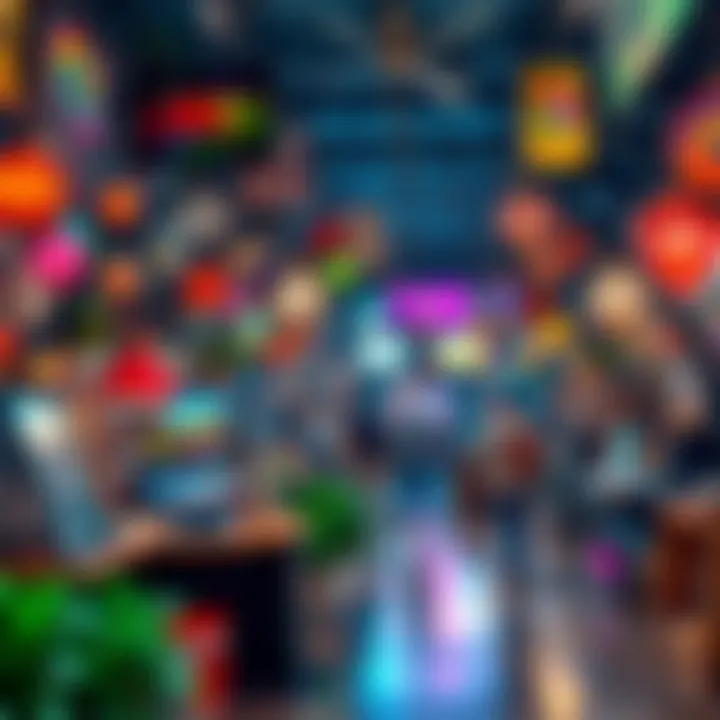
Navigating the intricate landscape of art NFTs extends far beyond mere creation and minting. A pivotal element in this journey is the understanding of legal considerations and ownership rights. For artists, grasping these concepts is essential not only for safeguarding their work but also for maximizing its potential value and impact in the digital marketplace.
Without a firm grasp of copyright, licensing, and protection strategies, creators may find themselves vulnerable to infringement or misappropriation of their art. Thus, this section will delve into three crucial areas: understanding copyright in the NFT space, licensing and usage rights, and effective strategies for protecting one's work in the digital environment.
Understanding Copyright in the NFT Space
Copyright is the legal backbone of creation—it grants artists exclusive rights to their own artistic expressions. In the context of NFTs, this means that artists can control the reproduction, distribution, and public display of their digital works. However, the relationship between NFTs and copyright is not as straightforward as it might seem.
Since NFTs serve as tokens representing ownership, they do not inherently encompass copyright. This disjunction can lead to confusion.
"Just because you own an NFT doesn’t mean you own the underlying intellectual property rights associated with that artwork."
For artists, this is crucial. They must clearly define whether buyers are purchasing the NFT with full copyright rights or merely the token itself. It’s wise to provide detailed terms of sale that outline these rights to avoid potential disputes later on.
Licensing and Usage Rights
Licensing is another layer of complexity in the NFT realm. Artists have the opportunity to define how others can utilize their artwork through licensing agreements. This could range from allowing personal use to permitting commercial exploitation.
When minting an art NFT, consider the various types of licenses:
- Exclusive Licenses: Grants the buyer exclusive rights to use the artwork.
- Non-Exclusive Licenses: Allows multiple parties to use the artwork simulateneously.
- Royalty Agreements: Set up a system where artists can earn a percentage of what the NFT resells for in the future.
Ensuring that licensing terms are clearly outlined not only protects the artist's interests but can also enhance the perceived value of the NFT. By facilitating this communication, artists can foster better relationships with buyers and build a reputation for transparency.
Protecting Your Work in a Digital Environment
The digital nature of NFTs brings about unique challenges regarding security and protection. The decentralized features of blockchain certainly add a layer of safety, but there are still measures an artist can take to further shield their work.
- Watermarking: This technique remains a useful method for deterring unauthorized use. It may involve placing a subtle mark on digital artworks to signify ownership.
- Engaging Legal Counsel: Consulting with a lawyer who specializes in digital law can help artists understand their rights and how to enforce them effectively.
- Staying Informed on Digital Developments: The NFT space is continually evolving. Following industry news and legal updates can empower artists to adapt and safeguard their work proactively.
By being aware of these legal considerations and ownership rights, artists can navigate the complex NFT landscape more confidently. They can harness the power of their work while defending their creative integrity in a rapidly changing digital marketplace.
Marketing Your Art NFT
In the ever-evolving landscape of digital art, understanding how to effectively market your art NFT can mean the difference between obscurity and recognition in a crowded field. Marketing isn’t just an adjunct to selling your artwork; it’s a vital cog in the machinery that drives your visibility, sales, and, ultimately, your success as a digital artist. Artists need to showcase their work in an engaging way and connect with potential buyers while building a brand that resonates with their target audience. This section aims to delve into the intricacies of how to market your art NFTs effectively, highlighting strategies and considerations that can enhance your outreach and boost your sales.
Building Your Brand as an Artist
A strong personal brand is like a lighthouse in the foggy sea of the digital art world. It not only sets you apart but also fosters a sense of trust and recognition among potential collectors. Start by defining a clear artistic identity, which encompasses your style, values, and mission. Think about what makes your art distinctive. Is it your technique? The themes you explore? Or perhaps the messages woven through your pieces?
Once you have a grasp on your identity, ensure it reflects in every piece of communication. Your online presence should be consistent, be it on your website, social media, or NFT platforms. Collaborate with designers to develop a memorable logo, and utilize cohesive design across your portfolios and galleries. Remember, every detail—from your bio to your visual aesthetics—tells a story about you and your art.
Establishing your brand is an ongoing process, but it’s crucial for setting the stage for effective marketing. When collectors recognize your brand, they’re more likely to become repeat buyers.
Effective Strategies for Promotion
Getting noticed in the NFT space can feel like searching for a needle in a haystack, but strategic promotion can cut through the noise. Here’s a variety of effective strategies:
- Email Marketing: Build a mailing list through your website. Keep followers updated on new releases, exclusive offers, and upcoming exhibitions.
- Participate in Relevant Conversations: Engage with communities on platforms like Reddit or Discord. Share your insights and work while contributing meaningfully to discussions.
- Join or Host Live Streams: Engage in virtual events, showcasing your work and explaining your process. This not only showcases your art but also humanizes you as an artist.
- Collaborate with Influencers: Find influencers who align with your brand. A shout-out from a respected figure can accelerate your reach exponentially.
- Traditional Media Exposure: Don't underestimate the power of offline marketing. Local art shows, magazine features, or radio interviews can draw attention to your work.
Engaging with the NFT Community
In the ever-evolving landscape of digital art, engaging with the NFT community is not just beneficial, it's essential. This vibrant ecosystem is teeming with opportunities that go beyond mere visibility; it fosters connections, stimulates creativity, and builds enduring relationships. Artists must recognize that collaboration and dialogue within this community not only amplify their reach but also enrich their understanding of the market's pulse.
By immersing oneself in this environment, an artist stands to gain valuable insights, update their innovative arsenal, and potentially discover revenue streams that were previously obscured by the digital noise.
Networking Opportunities in the Digital Art World
The power of networking in the NFT community can’t be overstated. When artists take the initiative to connect with their peers, they open doors to countless opportunities. These networks are not just communication channels; they are lifelines to collaborations, partnerships, and partnerships that can redefine one's artistic career.
- Participating in blockchain forums or Discord groups dedicated to NFT discussions can enhance visibility.
- Artists can exchange ideas, share experiences, and even receive constructive criticism on their work.
- Virtual meetups and online conferences can be pivotal for showcasing artworks to a broader audience and potential buyers.
"Networking can be the golden key to unlocking new dimensions in your artistic journey."
Engaging with fellow creators might also lead to joint artistic endeavors, which can result in unique, hybrid projects that draw attention and intrigue from collectors.
Participating in Virtual Galleries and Exhibitions
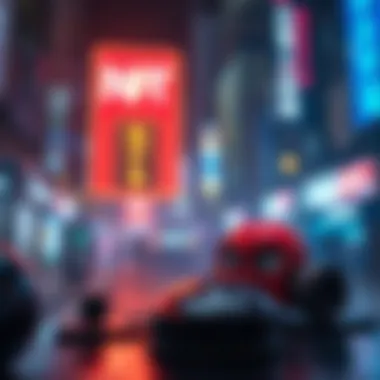

The advent of virtual galleries has revolutionized how artists display their work. Unlike traditional galleries, online platforms can host countless exhibits without the spatial constraints that come with physical locations. Artists can showcase their NFTs in engaging ways that resonate with a global audience.
- Platforms like OpenSea or Rarible offer artists the chance to list their works in curated galleries.
- Participating in virtual art shows allows for an immersive experience where audiences can explore the art without geographic limitations.
Furthermore, participating in established virtual exhibitions can increase credibility while strengthening the artist's online presence. The feedback gained from visitors, both positive and constructive, can serve as fodder for future projects.
Collaboration with Other Artists
Collaboration is at the heart of creative growth, and within the NFT community, cooperative endeavors can be particularly fruitful. By teaming up with other artists, individuals can blend styles, share audiences, and create artworks that neither could accomplish alone.
- Collaborative projects can take various forms, from joint NFT releases to shared creative workshops.
- These partnerships can also create buzz in the market, attracting attention from both existing and new collectors.
With the digital nature of NFTs, artists might find it easier than ever to work together across continents, breaking traditional barriers and expanding their creativity in ways previously unattainable.
Tracking and Analyzing Your NFT Sales
Tracking and analyzing your NFT sales is not just a matter of curiosity; it’s fundamental to understanding your performance in the digital art market. This aspect allows artists to gain insights into what resonates with buyers, how well their pieces are performing, and where improvements can be made. By diving into sales data, you can develop strategies that will ultimately lead to more refined offerings and better engagement with your target audience.
Understanding NFT Analytics Tools
Analytics tools can be the backbone of a successful NFT strategy. They help in gathering and interpreting data related to your art sales. Tools like Dune Analytics or Nansen offer insights into on-chain metrics that may guide your decisions. What to look for?
- Sales Volume: Keep track of how many of your NFTs have been sold and at what price. It helps in establishing the market value of your work.
- Buyer Demographics: Knowing who is buying can tailor your marketing strategies effectively.
- Traffic Sources: Understanding where buyers are finding your work allows focused marketing efforts.
As with many things, knowledge is power in this digital realm. Utilizing analytics tools can significantly impact future sales and promotions.
Evaluating Market Trends and Performance
To stay relevant in the fast-changing landscape of NFTs, evaluating market trends and performance is crucial. Consider these aspects:
- Contemporary Trends: What styles or themes are gaining traction? Observing social media trends or platforms like OpenSea can yield hints.
- Price Fluctuations: What are the average selling prices for similar art pieces? A keen eye can spot whether your prices align with market values or if you need to recalibrate.
- Rarity and Scarcity: The uniqueness of an NFT often influences desirability. Evaluating how your pieces fit within the rarity metrics can enhance their appeal.
Using market analysis not only increases your awareness but also helps anticipate likely changes that may impact your sales.
Adjusting Strategies Based on Insights
Once you have gathered and analyzed this data, it’s time to put that insight to work. Adjusting your strategies based on findings can make all the difference:
- Refining Your Art: If certain styles sell better, consider focusing on them.
- Marketing Tweaks: Use insights from traffic sources to target social media ads more effectively.
- Community Engagement: Engaging with buyers who show interest can cultivate loyalty.
Adapting quickly and decisively to changing conditions can help maintain and even spur growth in your sales. Remember, the digital art world is fluid, so your approach should be dynamic as well.
"In the world of NFTs, what sold yesterday may not sell tomorrow. Keeping your finger on the pulse is essential for lasting success."
As you navigate through your NFT journey, balancing creativity with analytics can lead to lucrative opportunities. Keeping track of your sales and understanding the numbers may require time and effort, but in a field as competitive as this, it’s often the difference between remaining a nameless artist or becoming a sought-after creator. To learn more about the advanced analytics tools and strategies for Monetizing NFTs, consult resources from sites like Dune Analytics.
Embrace this unique combination of artistry and business acumen. The art world is watching, and so are your potential buyers.
Future of Art NFTs
As we navigate this rapidly changing landscape of digital creation, the future of art NFTs stands tall on the horizon, promising to reshape not just how art is created, but also how it's consumed and valued. But why is this topic crucial for our discussion? Understanding the trajectory of art NFTs helps artists and investors keep a finger on the pulse of industry trends, allowing them to adapt and thrive in the digital art era. With each evolution in technology, the opportunities for artists grow, but so do the intricacies of the NFT market.
Emerging Trends in Digital Art
The digital art scene is experiencing a renaissance fueled by NFTs. One of the most notable trends is the shift toward interactive art. Artists now leverage advanced tech like augmented reality (AR) and virtual reality (VR) to create immersive experiences, which deepen the connection between the artwork and its audience. These experiences allow collectors to engage with art on a level that traditional media simply can't match. Additionally, generative art—where algorithms create unique pieces—is on the rise, challenging our fundamental notions of creativity and authorship.
- Rise of Digital Collectibles: Artists are increasingly partnering with gaming companies or creating bespoke experiences for collectors, adding layers to ownership.
- Integration of Social Causes: More artists are aligning their NFTs with social impact, using their platforms to support charitable causes and raise awareness on issues that resonate.
- Increased Focus on Sustainability: As artists aim to minimize their environmental footprint, choosing eco-friendly platforms and advocating for sustainable practices is becoming more prevalent.
“The future of art NFTs will most likely lie in their ability to expand beyond mere ownership; they are also about experience and community.”
Potential Challenges Ahead
Despite the tantalizing prospects, the road ahead isn’t without its bumps. For one, there’s the issue of market oversaturation. As more artists flood the NFT market, distinguishing oneself can be daunting. Collectors may experience fatigue, resulting in lower demand for some pieces. Furthermore, the lack of standardization in pricing can lead to unpredictability, making it challenging for artists to establish fair and consistent valuations for their work.
- Legal Issues: Copyright disputes and the decentralized nature of blockchain also raise concerns. Many artists worry about the protection of their intellectual property, especially when their works are tokenized.
- Technological Barriers: Many artists still find the technology surrounding NFTs complex. Navigating wallets, marketplaces, and minting processes can be a steep learning curve, leaving some potential creators on the sidelines.
The Role of Artists in Shaping the Future
Artists are not merely observers in this evolving space; they are at its forefront. Their creativity fuels the trend, but their advocacy for ethical practices and fair treatment in the NFT space shapes how the industry evolves. Artists have the unique power to influence not only the types of work that gain popularity but also how they are marketed and sold. By championing transparency and integrity within the community, they can help build trust among collectors and fellow creators.
- Educating Consumers: Artists who share knowledge about NFTs help demystify the process, promoting a more informed base of buyers.
- Forming Collectives: Collaborating in groups can amplify their voices and give a sense of community, allowing for pooled resources and shared knowledge.
- Innovating Art Forms: Artists exploring interdisciplinary approaches—combining visual art with music, performance, and technology—can expand the definition of what an NFT can be.
As we look to the future, the potential for art NFTs is, quite frankly, boundless. The challenges don't overshadow the synthesis of creativity, community, and commerce that this new medium fosters. For artists, traders, and tech enthusiasts, staying ahead in this domain isn't just an advantage; it’s essential.

